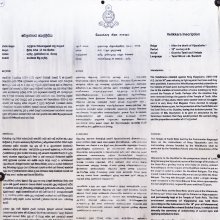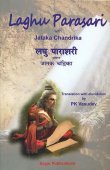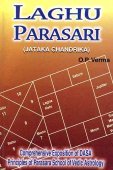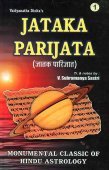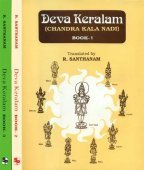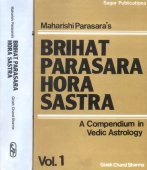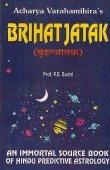Dasa, Dāsa, Daśā, Dasā, Daśa, Dāśa, Daśan, Dasha, Dashan: 43 definitions
Introduction:
Dasa means something in Buddhism, Pali, Hinduism, Sanskrit, Jainism, Prakrit, the history of ancient India, Marathi, Hindi, biology. If you want to know the exact meaning, history, etymology or English translation of this term then check out the descriptions on this page. Add your comment or reference to a book if you want to contribute to this summary article.
The Sanskrit terms Daśā and Daśa and Dāśa and Daśan can be transliterated into English as Dasa or Dasha or Dasan or Dashan, using the IAST transliteration scheme (?).
Alternative spellings of this word include Daas.
Images (photo gallery)
In Hinduism
Jyotisha (astronomy and astrology)
Source: Wisdom Library: Brihat Samhita by VarahamihiraDaśā (दशा) refers to the “planetary divisions and sub-divisions” (in relation to one’s life), according to the Bṛhatsaṃhitā (chapter 2), an encyclopedic Sanskrit work written by Varāhamihira mainly focusing on the science of ancient Indian astronomy astronomy (Jyotiṣa).—Accordingly, “We shall now proceed to give a brief description of (the qualifications of) a jyotiṣaka. [...] He must know the temperament of the planets; the parts of the body lorded over by each; the mineral division of each; the caste, sex and authority of each and the like; he must be able to state, from the time of conception or birth of a person, particulars connected with these occasions so as to insure belief; he must be able to say in what cases a child will die in infancy, and to calculate the period of one’s existence; he must be able to divide one’s life into planetary divisions and sub-divisions [i.e., daśā]; [...]”.
Source: WikiPedia: Hindu AstrologyThe word Dasha (दशा, 'planetary period') means 'state of being' and therefore the Daśā governs to a large extent the state of being of a person. The Daśā system shows which planets may be said to have become particularly active during the period of the Daśā. The ruling planet (the Daśānātha or 'lord of the Daśā') eclipses the mind of the native, compelling him or her to act as per the nature of the planet.
There are several dasha systems, each with its own utility and area of application. There are Daśās of Grahas (planets) as well as Daśās of the Rāśis (signs). The primary system used by astrologers is the Viṃśottarī Daśā system, which has been considered universally applicable in the Kaliyuga to all horoscopes.

Jyotisha (ज्योतिष, jyotiṣa or jyotish) refers to ‘astronomy’ or “Vedic astrology” and represents the fifth of the six Vedangas (additional sciences to be studied along with the Vedas). Jyotisha concerns itself with the study and prediction of the movements of celestial bodies, in order to calculate the auspicious time for rituals and ceremonies.
Purana and Itihasa (epic history)
Source: archive.org: Puranic Encyclopedia1) Dāśa (दाश).—A country in Ancient India. (Mahābhārata Bhīṣma Parva, Chapter 9, Stanza 56).
2) Dāsa (दास).—A term used as a suffix to the name of a Śūdra. In ancient India the rule was that the proper suffix for a Brahmin’s name should be 'Śarmā', for a Kṣatriya’s name, 'Varmā', for a Vaiśya’s name, 'Gupta' and for a Śūdra’s name, 'Dāsa'. (See under Cāturvarṇya).
Source: archive.org: Shiva Purana - English Translation1) Dāsa (दास) refers to “slaves”, according to the Śivapurāṇa 2.2.19. Accordingly as Brahmā narrated to Nārada:—“[...] then all the Devas and the sages, extremely terrified, began to eulogise Him who was blazing there:—‘[...] O great lord, you are the father of the universe. Satī is the mother of the universe. O lord of Devas, Viṣṇu, Brahmā and others are all your slaves (Dāsa)’”.
2) Dāsa (दास) refers to a “slave”, according to the Śivapurāṇa 7.42.—Accordingly, as Dakṣa bowed and eulogised Śiva:—“[...] O Śiva, out of delusion. I too have committed offence against you since I took sides with Dakṣa and fought with Vīrabhadra, Thy attendant. O Sadāśiva, Thou art my master, the supreme Brahman. I am Thy slave (i.e., dāsa). I shall be sustained by Thee always since thou art the father unto us all”.
Source: Cologne Digital Sanskrit Dictionaries: The Purana Index1) Daśa (दश).—One of Danu's sons.*
- * Vāyu-purāṇa 68. 9.
2) Dāsa (दास).—Servants entertained in a śrāddha;1 appellation of the Śūdras.2
Source: JatLand: List of Mahabharata people and placesDāsa (दास) is a name mentioned in the Mahābhārata (cf. VIII.30.73) and represents one of the many proper names used for people and places. Note: The Mahābhārata (mentioning Dāsa) is a Sanskrit epic poem consisting of 100,000 ślokas (metrical verses) and is over 2000 years old.
Daśa is also mentioned in the Mahābhārata (cf. VI.10.54, VI.10.65) and represents one of the many proper names used for people and places.

The Purana (पुराण, purāṇas) refers to Sanskrit literature preserving ancient India’s vast cultural history, including historical legends, religious ceremonies, various arts and sciences. The eighteen mahapuranas total over 400,000 shlokas (metrical couplets) and date to at least several centuries BCE.
Ayurveda (science of life)
Kalpa (Formulas, Drug prescriptions and other Medicinal preparations)
Source: Shodhganga: Edition translation and critical study of yogasarasamgrahaDaśa refers to “pulp” [in the Malayalam language] and represents one of the various diseases mentioned in the 15th-century Yogasārasaṅgraha (Yogasara-saṅgraha) by Vāsudeva: an unpublished Keralite work representing an Ayurvedic compendium of medicinal recipes. The Yogasārasaṃgraha [mentioning daśa] deals with entire recipes in the route of administration, and thus deals with the knowledge of pharmacy (bhaiṣajya-kalpanā) which is a branch of pharmacology (dravyaguṇa).

Āyurveda (आयुर्वेद, ayurveda) is a branch of Indian science dealing with medicine, herbalism, taxology, anatomy, surgery, alchemy and related topics. Traditional practice of Āyurveda in ancient India dates back to at least the first millenium BC. Literature is commonly written in Sanskrit using various poetic metres.
Shaivism (Shaiva philosophy)
Source: Brill: Śaivism and the Tantric TraditionsDaśā (दशा) refers to a “state” (e.g., ‘the state called beyond the fourth’), according to the Īśvarapratyabhijñākārikā III.2.12.—Accordingly, “When further [the layers of the objective “self”] from the Void to the [very] tissues of the body are transmuted by means of the ‘alchemical elixir,’ i.e. by the [fundamental] ‘I’-sense which is certainly conjoined with the qualities of magnificent power, eternality, sovereignty, [and others] of such nature that are cognized [as aspects of that ‘I’], then in this state [called] Beyond the Fourth (turyātīta-daśā) they abandon (as it were) their objectivity”.

Shaiva (शैव, śaiva) or Shaivism (śaivism) represents a tradition of Hinduism worshiping Shiva as the supreme being. Closely related to Shaktism, Shaiva literature includes a range of scriptures, including Tantras, while the root of this tradition may be traced back to the ancient Vedas.
Ganitashastra (Mathematics and Algebra)
Source: archive.org: Hindu MathematicsDaśa (दश) refers to “ten” (10) in various lists of numeral denominations, according to gaṇita (“science of calculation”) and Gaṇita-śāstra, ancient Indian mathematics and astronomy.—We can definitely say that from the very earliest known times, ten has formed the basis of numeration in India. While the Greeks had no terminology for denominations above the myriad (104), and the Romans above the milk (103), the ancient Hindus dealt freely with no less than eighteen denominations [e.g., daśa]. Cf. Yajurveda-saṃhitā (Vājasanyī) XVII.2; Taittirīya-saṃhitā IV.40.11, VII.2.20.1; Maitrāyaṇī-saṃhitā II.8.14; Kāṭhaka-saṃhitā XVII.10, XXXIX.6; Anuyogadvāra-sūtra 142; Āryabhaṭīya II.2; Triśatikā R.2-3; Gaṇitasārasaṃgraha I.63-68.
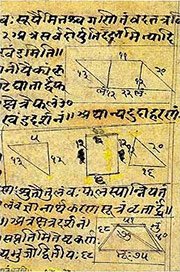
Ganitashastra (शिल्पशास्त्र, gaṇitaśāstra) refers to the ancient Indian science of mathematics, algebra, number theory, arithmetic, etc. Closely allied with astronomy, both were commonly taught and studied in universities, even since the 1st millennium BCE. Ganita-shastra also includes ritualistic math-books such as the Shulba-sutras.
Shaktism (Shakta philosophy)
Source: Google Books: ManthanabhairavatantramDāsa (दास) refers to a “servant”, according to the Kubjikāmata-tantra, the earliest popular and most authoritative Tantra of the Kubjikā cult.—Accordingly, “[...] Anyone who has found a teacher like this is released from bondage. The disciple who has seen him should worship the teacher with all his feeling. [...] He should offer himself as his servant (dāsa-tva) and worship him, (offering) himself and (his) wealth, until the teacher is satisfied. When he is satisfied, he initiates the disciple and so his fetters are destroyed. [...]”.

Shakta (शाक्त, śākta) or Shaktism (śāktism) represents a tradition of Hinduism where the Goddess (Devi) is revered and worshipped. Shakta literature includes a range of scriptures, including various Agamas and Tantras, although its roots may be traced back to the Vedas.
Yoga (school of philosophy)
Source: ORA: Amanaska (king of all yogas): A Critical Edition and Annotated Translation by Jason BirchDaśā (दशा) refers to a “state (of Yoga)”, according to Rājānaka Alaka’s commentary on the 9th-century Haravijaya by Rājānaka Ratnākara.—Accordingly, “[This] state (daśā) of Yoga is without discursive cognition (asaṃprajñāta), that is, without the activity of the mind whose nature is discursive thought. [That is to say, it is] without mind”.

Yoga is originally considered a branch of Hindu philosophy (astika), but both ancient and modern Yoga combine the physical, mental and spiritual. Yoga teaches various physical techniques also known as āsanas (postures), used for various purposes (eg., meditation, contemplation, relaxation).
General definition (in Hinduism)
Source: archive.org: Vedic index of Names and SubjectsDaśā (दशा) denotes the ‘fringe’ or ‘border’ of a garment (vāsaḥ) in the Śatapatha-brāhmaṇa. The word also occurs in the compound daśā-pavitra, which means ‘a filtering cloth with a fringe.’
In Buddhism
Mahayana (major branch of Buddhism)
Source: Wisdom Library: Maha Prajnaparamita SastraDāsa (दास) is the name of a blind sailor that knew the route to king Sāgara, according to the 2nd century Mahāprajñāpāramitāśāstra (chapter XX). Accordingly, “The bodhisattva, who had heard that there was a cintāmaṇi in the head of the Nāga king Sāgara (read So k’ie lo), asked the crowd: ‘Does anyone know the way leading to this Nāga’s palace?’ A blind man (andhapuruṣa) named T’o chö (Dāsa), who seven times previously had been on the high seas knew the sea route in question”.
Source: academia.edu: A Study and Translation of the Gaganagañjaparipṛcchā1) Daśa (दश) refers to “ten (stages)”, according to the Gaganagañjaparipṛcchā: the eighth chapter of the Mahāsaṃnipāta (a collection of Mahāyāna Buddhist Sūtras).—Accordingly, “How then, son of good family, does the Bodhisattva appear to many beings performing the deeds of a Buddha (buddhakārya) even when the Buddhas do not appear? Son of good family, [...] (7) he has perfected the purification of the ornaments of body, speech, thought, the auspicious marks and signs by accumulating all collections of merits; (8) he has perfected the purification of the ten stages (daśa-bhūmi) by obtaining the stage of consecration; (9) he has perfected the purification of all qualities of the Buddha by accumulating the collection of knowledges”.
2) Dāsa (वादित) refers to “male servants”, according to the Gaganagañjaparipṛcchā.—Accordingly: “Then the Bodhisattva Apāyajaha addressed himself to the Bodhisattva Gaganagañja: ‘Son of good family, please pacify three evil existences’. [...] Then, the rain of gifts, such as flowers, garlands, incenses, unguents, aromatic powers, religious robes, parasols, banners, pennons, five kinds of musical instruments, songs, male servants (dāsa), female servants, wives, boys, girls, female attendants, horses, elephants, [...] poured down from the open space. [...]”.

Mahayana (महायान, mahāyāna) is a major branch of Buddhism focusing on the path of a Bodhisattva (spiritual aspirants/ enlightened beings). Extant literature is vast and primarely composed in the Sanskrit language. There are many sūtras of which some of the earliest are the various Prajñāpāramitā sūtras.
General definition (in Buddhism)
Source: Wisdom Library: BuddhismDaśa (दश, “ten”) is the second of sixty digits (decimal place) in an special enumeration system mentioned by Vasubandhu in his Abhidharmakośa (“treasury of knowledge”). The explanations of the measure of years, eons, and so forth must be comprehended through calculation based on a numerical system. Enumeration begins from one and increases by a factor of ten for each shift in decimal place. The sixtieth number in this series is called “countless”.
Among these decimal positions (e.g., daśa, “ten”), the first nine positions from one to one hundred million are called ‘single set enumeration’. From a billion up to, but not including countless is “the enumeration of the great companion” and is called the ‘recurring enumeration’.
In Jainism
General definition (in Jainism)
Source: The University of Sydney: A study of the Twelve ReflectionsDaśan (दशन्) refers to the “ten (characteristics)” (of the doctrine), according to the 11th century Jñānārṇava, a treatise on Jain Yoga in roughly 2200 Sanskrit verses composed by Śubhacandra.—Accordingly, “Homage to that wishing tree that is the doctrine which is certainly succulent with compassion, by which the world is made pure, indeed by which it is maintained. That very same doctrine is proclaimed by the Jinas as possessed of ten characteristics (daśan-lakṣma-yuta), having honoured even a part of which those who have subdued their senses obtain liberation”.

Jainism is an Indian religion of Dharma whose doctrine revolves around harmlessness (ahimsa) towards every living being. The two major branches (Digambara and Svetambara) of Jainism stimulate self-control (or, shramana, ‘self-reliance’) and spiritual development through a path of peace for the soul to progess to the ultimate goal.
India history and geography
Source: academia.edu: The Chronology of Ancient Gandhara and BactriaAccording to Mahabharata, Dasha tribe was living in North-western region of Bactria. In all probability, Dasha (“Dahae” in Persian language) was a confederacy of 10 tribes like Tarkshya, Parada, Pahlava, Parshva etc., and dominated in the east of Caspian Sea (modern Turkmenistan). In my opinion, the word “Parada”(a tribe of western Turkmenistan) might have evolved into Parni and Parthia. It appears that Tarkhsyas dominated the confederacy of 10 tribes. Thus, the area of the east of Caspian Sea came to be known as Turan.

The history of India traces the identification of countries, villages, towns and other regions of India, as well as mythology, zoology, royal dynasties, rulers, tribes, local festivities and traditions and regional languages. Ancient India enjoyed religious freedom and encourages the path of Dharma, a concept common to Buddhism, Hinduism, and Jainism.
Biology (plants and animals)
Source: Google Books: CRC World Dictionary (Regional names)Dasan in India is the name of a plant defined with Rhus mysurensis in various botanical sources. This page contains potential references in Ayurveda, modern medicine, and other folk traditions or local practices It has the synonym Searsia mysorensis (G. Don) Moffett (among others).
Example references for further research on medicinal uses or toxicity (see latin names for full list):
· Bothalia (2007)
· Prodromus Florae Peninsulae Indiae Orientalis (1834)
· A General History of the Dichlamydeous Plants (1832)
If you are looking for specific details regarding Dasan, for example chemical composition, diet and recipes, side effects, extract dosage, health benefits, pregnancy safety, have a look at these references.

This sections includes definitions from the five kingdoms of living things: Animals, Plants, Fungi, Protists and Monera. It will include both the official binomial nomenclature (scientific names usually in Latin) as well as regional spellings and variants.
Languages of India and abroad
Pali-English dictionary
Source: BuddhaSasana: Concise Pali-English Dictionarydasa : (in cpds.), one who sees. (adj.), ten.
Source: Sutta: The Pali Text Society's Pali-English Dictionary1) Dasa, 2 (-°) (Sk.-dṛśa; cp. dassa) seeing, to be seen, to be perceived or understood D.I, 18 (aññadatthu° sureseeing, all-perceiving=sabbaṃ passāmī ti attho DA.I, 111); Sn.653 (paṭiccasamuppāda°), 733 (sammad°); J.I, 506 (yugamatta°; v. l. dassa).—duddasa difficult to be seen or understood D.I, 12 (dhammā gambhīrā d.; see gambhīra); M.I, 167, 487; Sn.938; Dh.252; also as sududdasa Dh.36. (Page 316)
2) Dasa, 1 (Sk. daśa=Av. dasa, Gr. dέka, Lat. decem, Goth. taíhun, Oir. deich, Ags. tīen, Ohg. zehan fr. *dekm̊, a cpd. of dv+km̊=“two hands”) the number ten; Gen. dasannaṃ (Dh.137); Instr. dasahi (Kh III, ) & dasabhi (Vin.I, 38). In cpds. (-°) also as ḷasa (soḷasa 16) & rasa (terasa 13; pannar° 15; aṭṭhār° 18).
Metaphorical meaning. (A) In the first place 10 is used for measurement (more recent & comprehensive than its base 5); it is the no. of a set or comprehensive unity, not in a vague (like 3 or 5), but in a definite sense. (B) There inheres in it the idea of a fixed measure, with which that of an authoritative, solemn & auspicious importance is coupled. This applies to the unit as well as its decimal combinations (100, 1000). Ethically it denotes a circle, to fulfil all of which constitutes a high achievement or power. Application (A) (based on natural phenomena): dasa disā (10 points of the compass; see disā): Sn.719, 1122; PvA.71, etc.; d. lokadhātuyo Pv.II, 961 (=10X1000; PvA.138); d. māse (10 months as time of gestation) kucchiyā pariharitvā J.I, 52; PvA.43, 82.—(B) (fig.) 1. a set: (a) personal (cp. 10 people would have saved Sodom: Gen. 18, 32; the 10 virgins (2X5) Matt. 25, 1): divase divase dasa dasa putte vijāyitvā (giving birth to 10 sons day by day) Pv.I, 6.—(b) impersonal: 10 commandments (dasa sikkhāpadāni Vin.I, 83), cp. Exod. 34, 28; 10 attributes of perfection of a Tathāgata or an Arahant: Tathāgata-balāni; with ref. to the Buddha see Vin.I, 38 & cp. Vin. Texts I.141 sq.; dasah’aṅgehi samannāgato arahā ti vuccati (in memorizing of No. 10) Kh III, dasahi asaddhammehi sam° kāko J.III, 127;— 10 heavenly attributes (ṭhānāni): āyu etc. D.III, 146; S.V, 275; PvA.9, opp. 10 afflictions as punishment (cp. 10 plagues Exod. 7—11): dasannaṃ aññataraṃ ṭhānaṃ nigacchati Dh.137 (=das. dukkha-kāraṇānaṃ, enumerated v. 138, 139) “afflicted with one of the 10 plagues”; cp. DhA.III, 70.—10 good gifts to the bhikkhu (see deyyadhamma) Nd2 523; PvA.7; 10 rules for the king: PvA.161;— dividing the Empire into 10 parts: PvA.111; etc. vassa-dasa a decade: das’ev’imā vassa-dasā J.IV, 396 (enumerated under vassa); dasa-rāja-dhammā J.II, 367; das’akkosa-vatthūni DhA.I, 212.- See on similar sets A.V, 1—310; D.III, 266—271.—2. a larger unity, a crowd, a vast number (of time & space): (a) personal, often meaning “all” (cp. 10 sons of Haman were slain Esth. 9, 10; 10 lepers cleansed at one time Luke 17, 12): dasa bhātaro J.I, 307; dasa bhātikā PvA.111; dasa-kaññā-sahassa-parivārā PvA.210 etc. ‹-› (b) impersonal (cp. 10 X 10=many times, S.B.E. 43, 3): dasa-yojanika consisting of a good many miles DhA.III, 291. dasavassasahassāni dibbāni vatthāni paridahanto (“for ever and aye”) PvA.76, etc.
— or —
Dāsa, (Ved. dāsa; orig. adj. meaning “non-Aryan, ” i.e. slave (cp. Gr. baρbaros, Ger. sklave=slave); Av. dāha= a Scythian tribe. Also connected w. dasyu (see dassukhīla)) a slave, often combined w. f. dāsī. Def. by Bdhgh as “antojāto” (DA.I, 300), or as “antojātadhanakkīta-karamarânīta-sāmaṃ dāsabyaṃ upagatānaṃ aññataro” (ibid. 168).—In phrase dāsā ca kammakarā “slaves & labourers” Vin.I, 243, 272; II, 154; as dāso kammakaro “a slave-servant” D.I, 60 (cp. d.‹-› kammakara).—Vin.I, 72, 76 (dāso na pabbājetabbo: the slave cannot become a bhikkhu); D.I, 72; M.II, 68 (fig. taṇhā°); J.I, 200, 223; III, 343 (bought for 700 kahāpaṇas), 347; Pug.56; PvA.112.
— or —
Dasā, (f.) & dasa (nt.) (Sk. daśā) unwoven thread of a web of cloth, fringe, edge or border of a garment D.I, 7 (dīgha° long-fringed, of vatthāni); J.V, 187; DhA.I, 180; IV, 106 (dasāni).—sadasa (nt.) a kind of seat, a rug (lit. with a fringe) Vin.IV, 171 (=nisīdana); opp. adasaka (adj.) without a fringe or border Vin.II, 301=307 (nisīdana). —anta edge of the border of a garment J.I, 467; DhA.I, 180 sq., 391. (Page 316)

Pali is the language of the Tipiṭaka, which is the sacred canon of Theravāda Buddhism and contains much of the Buddha’s speech. Closeley related to Sanskrit, both languages are used interchangeably between religions.
Marathi-English dictionary
Source: DDSA: The Molesworth Marathi and English Dictionarydaśa (दश).—a (S) Ten. In comp. with Sanskrit words, as daśāvatāra, daśarātra, daśāha, daśadiśā &c., all of which, after this notice, it will be unnecessary to insert.
--- OR ---
daśā (दशा).—f (S) State or condition. 2 A period or stage of life, as youth, manhood &c. 3 A difficult or distressful condition; a pickle, plight, predicament. 4 The aspect or configuration of the planets; considered as influencing the fortunes of man. See mahādaśā & antardaśā. 5 (This is the plural of daśī) The unwoven ends of a cloth, the thrum. daśāñcēṃ pāgōṭēṃ or dhōtara A turban or dhotar having unwoven threads at its ends.
--- OR ---
dasa (दस).—a ( H) Ten. Pr. dasa gēlē pāñca rāhilē.
--- OR ---
dāśā (दाशा).—m A common term for the strengthening pieces of wood which are laid crosswise, at intervals, and built up within a thin wall: also for the stout pieces which are driven into the wall at its summit, to sustain the pākhāḍī (undergirding of the rafters).
--- OR ---
dāsa (दास).—m (S) A slave, or a servant for low offices. Ex. of comp. gṛhadāsa, bhagavaddāsa, strīdāsa, arthadāsa, viṣayadāsa. 2 A Shudra affix or appellation. 3 S A man of the fourth tribe. 4 A sage or philosopher.
Source: DDSA: The Aryabhusan school dictionary, Marathi-Englishdaśa (दश).—
--- OR ---
daśā (दशा).—f State or condition. A period or stage of life, as youth, manhood &c. A difficult or distressful condition; a pickle, plight, predicament. The aspect or configuration of the planets. The unwoven ends of a cloth, the thrum. (This is the plural of daśī.) daśāñcēṃ pāgōṭēṃ or dhōtara A turban or dhōtara having un- woven threads at its end.
--- OR ---
dasa (दस).—a Ten. Ex. dasa gēlē pāñca rāhilē.
--- OR ---
dāsa (दास).—m A slave, a servant for low offices A sage or philosopher.
Marathi is an Indo-European language having over 70 million native speakers people in (predominantly) Maharashtra India. Marathi, like many other Indo-Aryan languages, evolved from early forms of Prakrit, which itself is a subset of Sanskrit, one of the most ancient languages of the world.
Sanskrit dictionary
Source: DDSA: The practical Sanskrit-English dictionaryDaśan (दशन्).—Num. a. (pl.) Ten; स भूमिं विश्वतो वृत्वा अत्यतिष्ठद्दशाङ्गुलम् (sa bhūmiṃ viśvato vṛtvā atyatiṣṭhaddaśāṅgulam) Ṛgveda 1.9.1.
Source: DDSA: The practical Sanskrit-English dictionary
Daśā (दशा).—1 The threads at the end of a piece of woven cloth, the fringe of a garment, the skirt, edge or hem of a garment; रक्तांशुकं पवनलोलदशं वहन्ती (raktāṃśukaṃ pavanaloladaśaṃ vahantī) Mṛcchakaṭika 1.2; छिन्नां इवाम्बरपटस्य दशाः पतन्ति (chinnāṃ ivāmbarapaṭasya daśāḥ patanti) 5.4.
2) The wick of a lamp; श्रेयोदशाग्रे स्फुरन् (śreyodaśāgre sphuran) Bhartṛhari 3.129; Kumārasambhava 4.3.
3) Age or time of life; see दशान्त (daśānta) below.
4) A period or stage of life; as बाल्य, यौवन (bālya, yauvana), &c.; दारक्रियायोग्यदशं च पुत्रम् (dārakriyāyogyadaśaṃ ca putram) R.5.4.
5) A period in general.
6) State, condition, circumstances; नीचैर्गच्छत्युपरि च दशा चक्रनेमिक्रमेण (nīcairgacchatyupari ca daśā cakranemikrameṇa) Meghadūta 111; विषमां हि दशां प्राप्य दैवं गर्हयते नरः (viṣamāṃ hi daśāṃ prāpya daivaṃ garhayate naraḥ) H.4.3.
7) State or condition of mind.
8) The result of actions, fate.
9) The aspect or position of planets (at birth).
1) The mind, understanding.
--- OR ---
Dāśa (दाश).—
1) A fisherman; इयं च सज्जा नौश्चेति दाशाः प्राञ्जलयोऽब्रुवन् (iyaṃ ca sajjā nauśceti dāśāḥ prāñjalayo'bruvan) Rām.7.46.32; Manusmṛti 8.48,49;1.34.
2) A servant, (dāsa q. v.).
Derivable forms: dāśaḥ (दाशः).
--- OR ---
Dāsa (दास).—
1) Slave, servant in general; गृहकर्मदासाः (gṛhakarmadāsāḥ) Bh. 1.1; गृह°, कर्म° (gṛha°, karma°) &c.
2) A fisherman; निषादो मार्गवं सूते दासं नौकर्मजीविनम् (niṣādo mārgavaṃ sūte dāsaṃ naukarmajīvinam) Manusmṛti 1.34.
3) A Śūdra, a man of the fourth caste.
4) A knowing man, one who knows the universal spirit.
5) Name of Vṛtrāsura.
6) A demon.
7) A savage, barbarian (opp. ārya).
8) A worthy recipient (dānapātra).
9) A word added to the name of Śūdra; cf. गुप्त (gupta).
Derivable forms: dāsaḥ (दासः).
Source: Cologne Digital Sanskrit Dictionaries: Shabda-Sagara Sanskrit-English DictionaryDaśan (दशन्).—mfn. plu. (-śa) Ten. E. daś to bite, Unadi affix an, the nasal rejected.
Source: Cologne Digital Sanskrit Dictionaries: Shabda-Sagara Sanskrit-English DictionaryDaśā (दशा).—f.
(-śā) or m. plu.
(-śāḥ) 1. The ends of a piece of cloth, the end of a garment. 2. A state, a condition, a period or time of life, as youth, age, manhood, &c. 3. The wick of a lamp. 4. The mind or faculty, of understanding. 5. Aspect or position of the planets at birth. E. daś to bite, to cut or divide, or be cut or divided, aṅ aff.
--- OR ---
Dāśa (दाश).—m.
(-śaḥ) 1. A fisherman, the son of a Nishada by a woman of the Ayogava caste. 2. A servant. f. (-śī) 1. A female slave, &c. E. dāśṛ to give, affix ghañ . see dāsa .
--- OR ---
Dāsa (दास).—m.
(-saḥ) 1. A fisherman. 2. A servant, a slave. 3. A Sudra or man of the fourth tribe. 4. A Sudra affix or appellation. 5. A person to whom it is proper to make gifts. 6. A sage, one to whom it is proper nature of the soul is known. f. (-sī) A female servant or slave. 2. The wife of a slave, a fisherman or Sudra. 3. A harlot. 4. A plant, a sort of Barleria. E. dās to give, affix ghañ, to whom wages, &c. are given; also dāśa; otherwise, daśa or daṃśa to bite, &c. Unadi affix ṭhan, and the short vowel and nasal changed to ā .
Source: Cologne Digital Sanskrit Dictionaries: Benfey Sanskrit-English DictionaryDaśa (दश).—1. instead of daśan, Ten, Mahābhārata 3, 15649. 2. = daśama when latter part of a comp. numeral; cf. aṣṭādaśa, dvādaśa, tridaśa. nava -daśa, i. e. navan-, f. śī, Nineteenth. pañcadaśa, i. e. pañcan-, f. śī, 1. Fifteenth. 2. f. śī, The fifteenth day of a half month.
--- OR ---
Daśā (दशा).—i. e. daṃś + a, f. 1. The skirt, or the ends of a garment, [Mānavadharmaśāstra] 3, 44; [Mṛcchakaṭikā, (ed. Stenzler.)] 26, 17. 2. The wick of a lamp, [Bhartṛhari, (ed. Bohlen.)] 3, 1. 3. Condition, state of life, [Rāmāyaṇa] 3, 75, 59. 4. State, [Kathāsaritsāgara, (ed. Brockhaus.)] 7, 113. 5. Period, age, [Hitopadeśa] 10, 19; [Harivaṃśa, (ed. Calc.)] 4394.
--- OR ---
Dāśa (दाश).—written also dāsa dāsa, I. m. 1. A fisherman, Mahābhārata 1, 4012. 2. A boatman, Mahābhārata 1, 5875; [Mānavadharmaśāstra] 8, 408 (with s). 3. The son of a Niṣāda by an Āgoyava-woman, [Mānavadharmaśāstra] 10, 34 (with s). Ii. f. śī, A fisher-maid.
--- OR ---
Dāsa (दास).—i. e. probably dam + sa, I. m. A slave, a servant, [Mānavadharmaśāstra] 4, 253; 8, 416. Ii. f. sī, A female slave, a servant-maid, [Mānavadharmaśāstra] 9, 48. Cf. dāśa.
Source: Cologne Digital Sanskrit Dictionaries: Benfey Sanskrit-English DictionaryDaśan (दशन्).—cardinal number, 1. Ten, Mahābhārata 3, 10677. 2. Ten bad qualities, [Harivaṃśa, (ed. Calc.)] 744.
— Cf. [Gothic.] taihun and -tigu in tvaim-tigum; [Anglo-Saxon.] tên, -tig; [Latin] decem; cf. daśa.
Source: Cologne Digital Sanskrit Dictionaries: Cappeller Sanskrit-English DictionaryDaśa (दश).—(—°) = daśan.
--- OR ---
Daśā (दशा).—[feminine] fringe of a garment, wick of a lamp; [figuratively] state or condition of life; situation, circumstances i.[grammar]
--- OR ---
Dasa (दस).—[masculine] an inimical demon.
--- OR ---
Dāśa (दाश).—[masculine] fisherman, ferryman, mariner.
--- OR ---
Dāsa (दास).—1. [masculine] foe, [especially] an evil demon or an infidel ([opposed] ārya); servant, slave, [feminine] dāsī. dāsyāḥ putraḥ or putrī son or daughter of a slave (abusive words).
--- OR ---
Dāsa (दास).—2. [feminine] ī inimical, demoniacal; [masculine] foe, infidel, demon ([feminine] dāsī).
Source: Cologne Digital Sanskrit Dictionaries: Cappeller Sanskrit-English DictionaryDaśan (दशन्).—[adjective] ten.
--- OR ---
Daśan (दशन्).—[adjective] ten.
Source: Cologne Digital Sanskrit Dictionaries: Monier-Williams Sanskrit-English Dictionary1) Daśa (दश):—1. daśa ifc. for śā (ajpa-, udagetc.)
2) 2 mfn. ifc. (tri-, dvi-, nir-) and in [compound] for śan
3) Daśā (दशा):—[from daśa] a (ās) f. [plural] ‘Decads’, Name of 10 Jain texts (upāsaka-. etc.) consisting of 10 chs. each.
4) b f. (√daṃś?) the fringe of a garment, loose ends of any piece of cloth, skirt or hem, [Kātyāyana-śrauta-sūtra iv, 1, 17] (ūrṇā), [Lāṭyāyana viii, 6, 22; Kauśika-sūtra; Śāṅkhāyana-gṛhya-sūtra ii, 12, 5; Manu-smṛti] etc.
5) a wick, [Gobhila-śrāddha-kalpa iv, 2, 32] (kṣauma-), [Kumāra-sambhava iv, 30; Bhartṛhari iii, i]
6) state or condition of life, period of life (youth, manhood, etc.), condition, circumstances, [Rāmāyaṇa; Pañcatantra; Meghadūta] etc.
7) the fate of men as depending on the position of the planets, aspect or position of the planets (at birth etc.), [Varāha-mihira’s Bṛhat-saṃhitā; Varāha-mihira’s Bṛhajjātaka; Laghujātaka, by Varāha-mihira]
8) the mind, [cf. Lexicographers, esp. such as amarasiṃha, halāyudha, hemacandra, etc.]
9) cf. vastra-
10) [i.] daśa.
11) Dasa (दस):—[from das] m. a demon, [vi, 21, 11].
12) Dāśa (दाश):—[from dāś] 1. dāśa See puro-.
13) [from dāś] 2. dāśa or ([Uṇādi-sūtra v, 11]) dāśa (written also dāsa) fisherman, ferryman, mariner, [Vājasaneyi-saṃhitā xxx, 16; Mṛcchakaṭikā viii, 408, 9; Mahābhārata; Harivaṃśa] etc.
14) [v.s. ...] the son of a Niṣāda by a woman of the Āyogava caste, [Manu-smṛti x, 34]
15) [v.s. ...] servant, slave, [cf. Lexicographers, esp. such as amarasiṃha, halāyudha, hemacandra, etc.]
16) 3. dāśa the Vṛddhi form of 2. daśa in [compound]
17) Dāsa (दास):—[from dās] 1. dāsa m. fiend, demon
18) [v.s. ...] Name of certain evil beings conquered by Indra (e.g. Namuci, Pipru, Śambara, Varcin etc.), [Ṛg-veda]
19) [v.s. ...] savage, barbarian, infidel (also dāsa, opp. to ārya; cf. dasyu)
20) [v.s. ...] slave, servant, [Ṛg-veda; Atharva-veda; Manu-smṛti] etc.
21) [v.s. ...] a Śūdra, [cf. Lexicographers, esp. such as amarasiṃha, halāyudha, hemacandra, etc. [Scholiast or Commentator]]
22) [v.s. ...] one to whom gifts may be made, [Horace H. Wilson]
23) [v.s. ...] a fisherman ([varia lectio] for dāśa)
24) [v.s. ...] mfn. ifc. of names, [especially] of Śūdras and Kāya-sthas (but cf. also kāli-)
25) [from dās] mf(ī)n. fiendish, demoniacal, barbarous, impious, [Ṛg-veda]
26) 2. dāsa m. a knowing man, [especially] a knower of the universal spirit, [cf. Lexicographers, esp. such as amarasiṃha, halāyudha, hemacandra, etc.]
Source: Cologne Digital Sanskrit Dictionaries: Monier-Williams Sanskrit-English Dictionary1) Daśan (दशन्):—[from daśa] [plural] ([gana] svasr-ādi, [Gaṇaratna-mahodadhi 42]) ten ([nominative case] [accusative] daśa, [Ṛg-veda] etc.; [instrumental case] [daśa, [x, 101, 10 &]] daśabhis [locative case] sasu, [Ṛg-veda] etc.; both forms & śabhyas in Class. also oxyt. [Pāṇini 6-1, 177ff.])
2) [v.s. ...] cf. a-, δέκα.
Source: Cologne Digital Sanskrit Dictionaries: Yates Sanskrit-English DictionaryDaśan (दशन्):—(śa) a. Ten.
Source: Cologne Digital Sanskrit Dictionaries: Yates Sanskrit-English Dictionary1) Daśā (दशा):—(śā) 1. f. A state or condition; there are ten, redness of eyes, emotion of mind, mental resolve, disturbed rest, emaciation, indifference, immodesty, insanity, swooning and death; the ends of a piece of cloth; a wick; the mind; aspect of a planet.
2) Dāśa (दाश):—(śaḥ) 1. m. A fisherman; a servant. f. (śī) 5. a. Slave.
3) Dāsa (दास):—(saḥ) 1. m. A fisherman; a servant; a slave; a sudra. f. (sī) A slave; a harlot; Barleria.
4) nandinī (nī) 3. f. Satyāvatī the mother of Vyāsa.
Source: DDSA: Paia-sadda-mahannavo; a comprehensive Prakrit Hindi dictionary (S)Daśan (दशन्) in the Sanskrit language is related to the Prakrit word: Dasa.
Source: DDSA: Paia-sadda-mahannavo; a comprehensive Prakrit Hindi dictionary (S)Daśā (दशा) in the Sanskrit language is related to the Prakrit words: Dasā, Dāsa.
[Sanskrit to German]
Sanskrit, also spelled संस्कृतम् (saṃskṛtam), is an ancient language of India commonly seen as the grandmother of the Indo-European language family (even English!). Closely allied with Prakrit and Pali, Sanskrit is more exhaustive in both grammar and terms and has the most extensive collection of literature in the world, greatly surpassing its sister-languages Greek and Latin.
Hindi dictionary
Source: DDSA: A practical Hindi-English dictionary1) Daśa (दश):—(a) ten; (nm) the number ten; ~[kaṃṭha/kaṃdhara/grīva/mukha/mauli/śira/śīrṣa/śīśa] attributes of the demon king [rāvana; ~ratha] famous king of Ayodhya:, father of [rāma].
2) Daśā (दशा):—(nf) condition, state; plight; —[bigaḍanā] condition to take a turn for the worse; —[sudharanā] condition to improve.
3) Dasa (दस) [Also spelled das]:—(a) ten; (nm) the number ten; —[lākha] a million; —[naṃbarī] a notorious criminal; [dasoṃ diśāoṃ meṃ] all round, all over, everywhere.
4) Dāsa (दास) [Also spelled daas]:—(nm) a slave; servant, serf; thrall; —[bhāva] thraldom, the attitude of slavery, servility; ~[vāda] slavocracy; ~[vādī] a slavocract; slavocratic; —[prathā] (practice/system of) slavery, serfdom.
...
Prakrit-English dictionary
Source: DDSA: Paia-sadda-mahannavo; a comprehensive Prakrit Hindi dictionary1) Dasa (दस) in the Prakrit language is related to the Sanskrit word: Daśan.
2) Dasā (दसा) also relates to the Sanskrit word: Daśā.
3) Dāsa (दास) also relates to the Sanskrit word: Darśa.
4) Dāsa (दास) also relates to the Sanskrit word: Dāsa.
Prakrit is an ancient language closely associated with both Pali and Sanskrit. Jain literature is often composed in this language or sub-dialects, such as the Agamas and their commentaries which are written in Ardhamagadhi and Maharashtri Prakrit. The earliest extant texts can be dated to as early as the 4th century BCE although core portions might be older.
Kannada-English dictionary
Source: Alar: Kannada-English corpusDaśa (ದಶ):—[adjective] totalling ten; ten.
--- OR ---
Daśa (ದಶ):—[noun] the cardinal number ten; 10.
--- OR ---
Dasa (ದಸ):—[noun] an onomatopoeic word formed by imitating or representing the sound of heavy breathing.
--- OR ---
Dasa (ದಸ):—[adjective] totalling ten; ten.
--- OR ---
Dasa (ದಸ):—[noun] the cardinal number ten; 10.
--- OR ---
Dāśa (ದಾಶ):—
1) [noun] a man who fishes for living; a fisherman.
2) [noun] a caste the main occupation of the members of which is fishing.
3) [noun] a man engaged in menial works for another.
--- OR ---
Dāsa (ದಾಸ):—
1) [noun] a man engaged in menial and servile works for another; a slave 2.(contemp.) a man of low status.
2) [noun] a man addicted to (a bad habit).
3) [noun] an ardent devotee of Viṣṇu, who usu. leads an austere life.
4) [noun] a caste the members of which live on alms, wandering from place singing devotional songs.
5) [noun] a male member of this caste.
6) [noun] a fisherman.
Kannada is a Dravidian language (as opposed to the Indo-European language family) mainly spoken in the southwestern region of India.
See also (Relevant definitions)
Starts with (+728): Daasatv, Dasa Tathagata Bala, Dasa gosvamin, Dasa Parami, Dasa sharman, Dasa-bhritaka, Dasabala, Dasabala Kassapa, Dasabala Sutta, Dasabala Vagga, Dasabanajiga, Dasabharya, Dasabhava, Dasabhavashtaka, Dasabrahmana Jataka, Dasabusane, Dasabyata, Dasadaram, Dasadasaramamdava, Dasadasi.
Ends with (+427): Abhinavakalidasa, Acaladasa, Achyutadasa, Acyutadasa, Adasa, Addasa, Adidasa, Adityadasa, Agnishomiyapurodasha, Akabariya kalidasa, Akshivyudasa, Amatadasa, Amkadasa, Amla-vedasa, Amshadasha, Amtardasha, Anantadasa, Anirdasha, Annadasa, Annadatthudasa.
Full-text (+1538): Dashanandini, Dashapura, Ashtadasha, Dvadasha, Dasatva, Caturdasha, Dashakantha, Dasasata, Dashamaya, Dashalakshanaka, Dashanana, Dasharatha, Apadasha, Dashi, Dashaphala, Antakriddasha, Saptadashan, Dashamala, Dashalakshana, Dasharha.
Relevant text
Search found 159 books and stories containing Dasa, Dāsa, Daśā, Dasā, Daśa, Dāśā, Dāśa, Daśan, Dasan, Dasha, Dashan; (plurals include: Dasas, Dāsas, Daśās, Dasās, Daśas, Dāśās, Dāśas, Daśans, Dasans, Dashas, Dashans). You can also click to the full overview containing English textual excerpts. Below are direct links for the most relevant articles:
Garga Samhita (English) (by Danavir Goswami)
Verse 2.23.10 < [Chapter 23 - The Killing of Śaṅkhacūḍa During the Rāsa-dance Pastime]
Verse 1.1.32 < [Chapter 1 - Description of Śrī-Kṛṣṇa’s Glories]
Verse 2.12.6 < [Chapter 12 - Subduing Kāliya and Drinking the Forest Fire]
Rig Veda (translation and commentary) (by H. H. Wilson)
Graha Dasha < [Astrology In Garuda Purana]
List of Mahabharata people and places (by Laxman Burdak)
Bhajana-Rahasya (by Srila Bhaktivinoda Thakura Mahasaya)
Text 7 < [Chapter 6 - Ṣaṣṭha-yāma-sādhana (Sāyaṃ-kālīya-bhajana–bhāva)]
Text 11 < [Chapter 7 - Saptama-yāma-sādhana (Pradoṣa-kālīya-bhajana–vipralambha-prema)]
Text 11 < [Chapter 5 - Pañcama-yāma-sādhana (Aparāhna-kālīya-bhajana–kṛṣṇa-āsakti)]
Brihad Bhagavatamrita (commentary) (by Śrī Śrīmad Bhaktivedānta Nārāyana Gosvāmī Mahārāja)
Verse 2.4.25 < [Chapter 4 - Vaikuṇṭha (the spiritual world)]
Verse 1.4.65 < [Chapter 4 - Bhakta (the devotee)]
Verse 1.4.60 < [Chapter 4 - Bhakta (the devotee)]
Related products
(+5 more products available)
